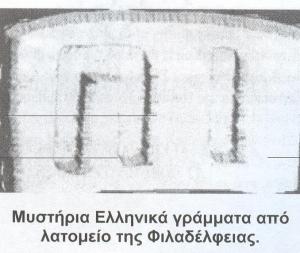"Ελληνικά» γράμματα ηλικίας 500-600 εκατομμύρια ετών βρέθηκαν σε λατομείο της Αμερικής.
Σε λατομείου μαρμάρου κοντά στην Φιλαδέλφεια της Αμερικής το 1978, και σε βάθος 60-70 πόδια βρέθηκε η πιο...
κάτω μαρμάρινη πλάκα . Φέρει τα «Ελληνικά» γράμματα Π και Ι και είναι πράγματι ένας πονοκέφαλος για τους συντηρητικούς αρχαιολόγους. Λέτε να έχουν δίκαιο αυτοί που λένε ότι εμείς οι Έλληνες ήμασταν στο παρελθόν τρεις φορές κοσμοκράτορες τελευταία με τον Διόνυσο στην Aσία ;
http://www.triklopodia.com
Πανάρχαιοι ελληνικοί χαρακτήρες σε ορυχείο;
Ημερομηνία: 05/06/2012
Καταχωριτής: Aragorn
Πηγή: http://anti-ntp.blogspot.com/2012/06/blog-post_5275.html?utm_source=feedburner&utm_medium=email&utm_campaign=Feed:+blogspot/RkuhN+%28%CE%91%CE%9D%CE%A4%CE%99-%CE%9D%CE%95%CE%91+%CE%A4%CE%91%CE%9E%CE%97+%CE%A0%CE%A1%CE%91%CE%93%CE%9C%CE%91%CE%A4%CE%A9%CE%9





1 Σχόλια:
Βρήκα και το πρωτότυπο :
n November 1829, workers at the Henderson Quarry near Norristown, 17 km (12 miles) north-west of Philadelphia (Pennsylvania, USA), cut a block from a layer of marble found at a depth of 18-21 m (60-70 feet) and estimated to be around eight million years old. While sawing through the block, workmen at the Savage Sawmill spotted a rectangular indentation, about 38 mm (1½ inches) wide by 16 mm (⅝ inch) high, with two raised characters inside it, one of which was said to resemble the Greek letters pi and iota (ΠΙ) (some accounts reverse the letters and make them IU) (Browne 1831, 361). Norristown has long been known for its marble and limestone, the latter being quarried commercially as early as the 1690s.
It is difficult to know what this is meant to demonstrate. Does the discovery mean that someone was writing using the Greek alphabet (or, if we reverse the figures, the modern Latin alphabet) eight million years ago? If so, how did the ‘letters’ come to be encased inside a block of marble? Whilst Greek inscriptions (or any other type) may easily be made on the surface of a marble block, it is impossible to inscribe inside marble, which is what this discovery would demand if we are to accept it as part of a writing system. This phenomenon is known as a simulacrum: something in nature that happens to resemble something else with meaning to the observer.
http://www.badarchaeology.com/?page_id=250